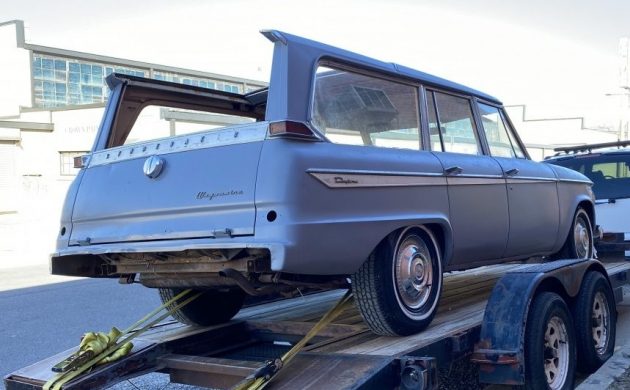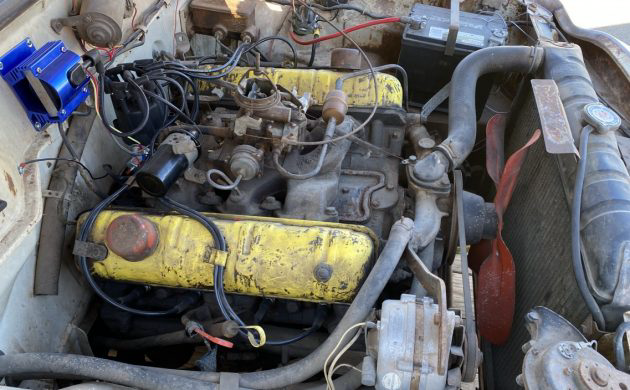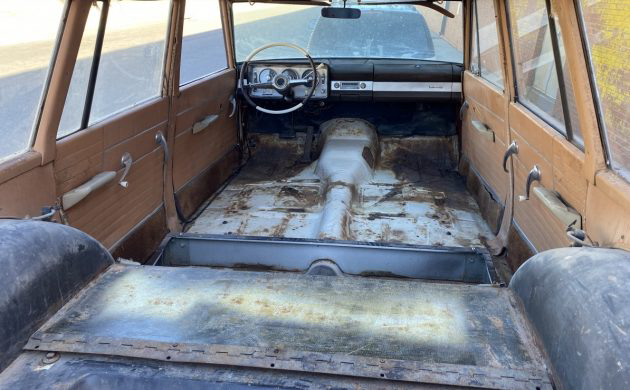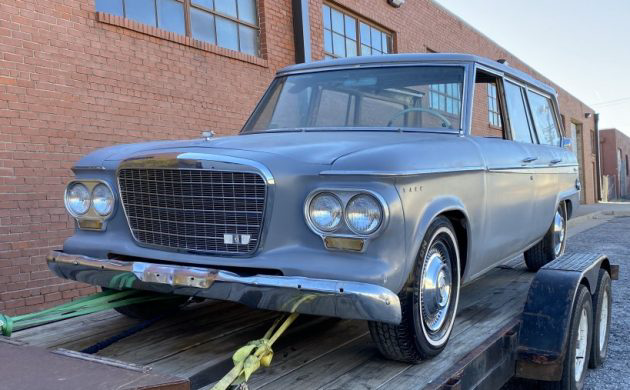Sliding Roof Special: 1963 Studebaker Wagonaire
The end of the line for Studebaker in the U.S. was upon us when this 1963 Lark Wagonaire station wagon was assembled. Actually, December 20th of that year was when the last cars rolled off of the South Bend, Indiana assembly line. How sad! Their lash-up with esteemed Packard several years earlier wasn’t enough to stave off the inevitable. And it wasn’t for lack of trying. New models like the Avanti helped with showroom traffic and the Wagonaire, with its unique sliding rood, should have been just the ticket in the station wagon crazy ’60s. With that thought, let’s examine this interesting people/cargo hauler. It is located in Oklahoma City, Oklahoma and is available, here on Barn Finds Classifieds for $6,000.
The most obvious feature of this wagon is its sliding roof which is pictured in the open position – an image of it in the closed position as not included in the listing. The body is pretty well covered in gray primer and the seller adds, “The rest of the body is quite straight but may need a little attention prior to paint“. There are some spare parts included in the sale but the rear bumper doesn’t appear to be one of them. All of the unique station wagon trim looks to be in place and the body panels show as being free of crash damage or other foibles. That’s a nice set of Studebaker wheel covers!
The engine is listed as a 283 CI V8 but I believe that is either an error or misprint and it is actually a 210 gross HP, “Thunderbolt” 289 CI powerplant. It’s listed as a non-runner since an electronic ignition conversion was started but not completed. Gear changing is courtesy of a three-speed automatic transmission. The mileage recording shows as 27K miles but an inquiry should be made for verification as to what’s believed to be the actual reading.
Things get interesting inside as the middle seat frame is stated as missing but the included images, however, show all of the seats to be missing so follow-up questions should be directed to the seller. From what can be seen, the floors are showing some surface rust but its extensiveness is not disclosed. The upholstery panels are fair, the dash pad has several cracks but the instrument panel and gauges still present pretty well. This is a dealer-installed A/C car but the unit appears to have been removed but is included in the sale. The headliner is no more but that missing item does allow one to view the mechanism that opens and closes the sliding roof panel.
The seller states, “… a wagon that can haul tall items like a refrigerator! Or carry the waving homecoming king and queen in a parade! As revolutionary as the concept was, it has only been seen in one other production model since — the GMC Envoy XUV” True enough, and I have always been surprised that feature hasn’t resurfaced today though it would find itself on an SUV. What do you think the reason for a modern-day no-show sliding roof is?
Auctions Ending Soon
 2002 Subaru Impreza WRXBid Now2 days$333
2002 Subaru Impreza WRXBid Now2 days$333
 1975 Chevrolet Corvette ConvertibleBid Now2 days$4,000
1975 Chevrolet Corvette ConvertibleBid Now2 days$4,000
 1964 Ford F-100 Camper CustomBid Now2 days$2,000
1964 Ford F-100 Camper CustomBid Now2 days$2,000
 2006 Jeep Wrangler SportBid Now4 days$10,500
2006 Jeep Wrangler SportBid Now4 days$10,500
 1974 Datsun 260ZBid Now6 days$200
1974 Datsun 260ZBid Now6 days$200






Comments
A good concept and one can see the rear similarities to the Jeep Grand Cherokee which was penned by the same designer. However these were problematic for water leaks which is the d same that could be said for the Envoy. I personally like it because it’s unusual but the market has voted twice 2 wrongs don’t make a right.
Doesn’t look like much water leaked in this one by the looks of that tire well.
The tailgate rust is just just like any other make.
Nice, did not expect to see the 8 cyl in there. You can definitely see Brooke Stevens’ hand in the design. As mentioned, Stevens also penned the Wagoneer. The sliding roof was a great idea that didn’t really play out that well in the real world…but I love them and they’re certainly rare
Studebaker would later source the Chevy 283 for the 1965 and 66 Canadian models. This is definitely a Studey engine. Could it be a 259 as well?
Could be a base 259 – just looking at the fan – this most likely is NOT a factory air car by the looks of the floor pan – don’t see a drain holes and with no other options under the hood – that aftermarket A/C along with the roof rack was just acquired and did not come on this car.
I surmised that it’s a 289 CI engine because of this car’s claimed “Daytona” trim level which was 289 province.
JO
The answer to the question of why no modern day no show sliding roofs?
Three words: personal injury lawyers
Not so fast; the 2004-5 GMC Envoy XUV had a retractable roof over the cargo area very similar to this Wagonaire, along with a midgate that could be used to enclose the passenger compartment while the cargo area was left open.
I clearly remember when these were introduced, my dad, who was a long-time Studebaker fan (I came home after birth in a 50 Commander convertible) said “watch, GM will invent one of these down the road” Studebaker was ahead of it’s time with many innovations. Their overall design just wasn’t what the public was looking for at the time.
Ah, the infamous Envoy XUV. The perfect vehicle for my pet giraffe, if I had a pet giraffe!
Can’t be any different than having a sunroof
It’s definitely NOT a 289… Ford engines had the distributor located in front of the carb,,, That is obviously a GM engine.
Studebaker had their own 289 V8 engine, same engine was used in the Hawks and the Avanti’s, including the Paxton blown engines.
And Studebaker’s 289 was available several years before Ford’s.
Correct – the first Stude 289 was in 1956 in the President.
Correct on the Ford comment – wrong on the Chevy comment.
It’s a 289 Studebaker engine, not a Ford.
JO
Looks like a Studebaker 289 to me. Definitely not Ford. The two were different as night & day.
It is impossible to tell if there is a 289 or a 259 cu inch Studebker engine by opening the hood and looking. The only way is to look at the serial number. And even then it’s difficult to see the number depending on what may be covering up the number. And even then, the blocks are identical.
The Y-block was the only Ford OHV V8 with the distributor at the back of the engine.
Back in 1963 I was 10 years old. Even then I had an eye for design and detail. I never cared for the Studebakers of the 60s. As with AMC Rambler, and Checker, they were square and boxy, no style or flair at all. But, as we get older and wiser (supposidly) our tastes change. Still don’t like the boxiness of these Studebakers, but I do like the uniqueness of the sliding roof. I’m glad the 2004 GMC Envoy was mentioned. I always wanted one because of the sliding roof. Who knows, maybe 40 years from now the Envoy will be on a classic car site like Barn Finds for it’s novelty.
Question, were these manual sliding roofs or power? Same question for the Envoy.
I have an 05 Envoy XUV and everything is motorized. it a really neat set up if you get a chance to see one in action.
The Studes were manual.
@ Bear
Make a video and post it
[email protected]
Not the end of the line…I owned a 1966 without the sliding roof.
It had a Chevy engine and an automatic with reverse at the end of the line
I meant the end of the line in the U.S.; I know Studebaker kept their Canadian plant open until March of ’66.
JO
Some 64s were made in South Bend. All 64s had Studebaker engines even those made in Canada. 65 and 66 had the GM engines since the foundry in South Bend was closed.
Years ago, my bud Nick in San Francisco, was a Studie freak. Had Avanti’s various Hawks, Champs, etc. His daily driver was a wagon like this, with the sliding roof. A neat feature. As I recall our incident of many years ago, one day we were stopped at a red light in the wagon and all of a sudden a guy was plastered on the hood. BAM! Just like that. He just materialized there! He slithered off, came to Nick’s window, and apologized for hitting us. He had run his motorcycle into the back of our stopped car and was launched off the bike and all the way over the car. He and his motorcycle continued on, as did the old Studie…no damage. The reality of what had just occurred stunned us as we drove off. Gosh.
I remember these well – caused quite the stir when they arrived on the streets. Studebaker tried hard to come up with a winning formula including the Avanti. The 65’s and 66’s with GM power trains were certainly a step ahead of the Studebaker units also just better cars with cleaner lines and better assembly.
I’ve had 3 of these Wagonaires, including a Daytona. The base engine for the Daytona was the 259, the regular wagon had a six as standard. Considering this car has no power steering or brakes, and very few other options [radio, heater, auto trans] I’m betting this is a 259 with 2 barrel carb.
The add-on A/C is not a Studebaker factory or dealer item. Based on what I see under the hood, this car has never had A/C, no holes in firewall for lines, no second pulley and fan belt, no evidence of a compressor bracket ever installed on engine.
What this car has going for it: It’s a Daytona Wagonaire, with very little rust.
What this car needs: minor rust repair, body work finished, complete paint job [have you priced decent paintwork lately?] Needs everything inside the car except for instrumentation. Needs gas tank, fuel system cleaned out and new fuel pump installed, and lots of minor work, assuming the engine is ok.
These cars [Daytona Wagonaire] are not very common, but they just don’t bring a lot of $. A very original and beautiful southern California version sold last October on Bring A Trailer for $32,000. This one will take a lot more than $26k to match it. While I don’t think the asking price is way high, with everything this car needs, I suspect it’s going to be a hard sell at that price.
GLWTS!
Correct Bill – like my 1964 Daytona hardtop with it’s base 259 – lucky they went with the 4 speed and twin traction – posi for some folks.
Stillrunners,
I remember in about 1976, another local SDC member here in Maryland found a 1964 Daytona Wagonaire, it was red with black interior, with the following options:
R2 Avanti supercharged* engine, Powershift automatic, Twin Traction rear. Bucket seats & tachometer. Power disc brakes, power steering, power windows. Tinted glass, dealer installed Studebaker A/C. *Supercharger was missing.
The problem was, while this was a very low mileage car, it had sat for years unused, under a thick grove of evergreen pines, and it was one of the worst rusted Studebakers I’d ever seen [and I’ve seen a lot of rusty Studies over the years].
Because the car was parked in a slight downward slope, the sliding roof drains had overflowed all the time, and the floors were GONE. Interior pieces were covered in mold. The doors wouldn’t stay shut because the center posts didn’t connect to anything at the bottom. Cowl was completely rotted out due to pine needle accumulations at the base of the windshield. I was told the pine needles had piled up under & against the car, at least a foot deep!
I don’t know what happened to the car, but I often imagined what this interesting and fast car must have been like when new.
Bill, can’t really remember that rusted R2 Daytona wagon – seems there was a Daytona wagon that came up awhile back with a factory 4 speed and documentation that was a driver – not sure what happed with that one either. Kinda have my hands full with my little Daytona and a 1963 R1 Cruiser….and my trucks.
Lawrence
I used to do the maintainence on a friends blue and blue 63 Daytona Wagonaire many years ago. It had an R-2 with 4 speed, power steering and I remember it had A/C with Disc brakes and Twin Traction. Gary had me do anything it needed because I had a 63 Daytona R,-2 and a 63 Avanti R-2 power shift. I loved both of those cars and wished I still had them. Still have Studes but not the fun ones.
Lawrence,
If you’ve been in the Studebaker club for a while, do you remember a parts supplier out of Maryland with the initials DW? That loaded Daytona wagon was sitting in his driveway, but this goes back 40+ years. I fear it may have been so rough, that back then, most Studebaker wagons were $100 to $500 cars, so he might have parted it out.
The missing parts are very problematic. I have seen the hard top version of this car and they are really cool looking when restored. Built “like a Truck”.
Parts are not that hard to find – most old wrecking yards have a Stude or two in them – and parts are copied thru the years. If all else fails – there’s the Studebaker Drivers Club classifieds site.
This is a Stude engine NOT a Chevie the Chevie did not come till the last gasp in 65,66 in Canada when they had no plant to make engines in. I sold these new they were a great idea. The roof were the same idea as a sun roof just at the other end of the vehicle. Just as a sun roof they had to have a way to drain the rain water so a trough was put in and hoses hooked to it great idea except the hoses would clog and then the interior got WET and then RUST. More so due to the fact Studebaker bought second line steel higher in carbon thus more prone to rust. The V/8 a very good and heavy motor (heavier than a Cadillac), came in a standard 259 Cubic inches and an optional 289 cubic inch even available with a Supercharger. easy to identify on the front at the top stamping V=259 P=289. The frame was also heavier on the Wagonaire to make up for less strength in the body
theres one of these in the junk yard where i live it also has the retractable rear roof
While that 289 can be built potently, just put an LS 1 in it
Cool! Never knew these existed. Great concept and this one looks like a good, clean start to a unique project. It would be a crowd-pleaser at shows when finished for sure. Neat looking roof mechanism (in ad pics), too. A Ford Flex interior might fit in this nicely.
There is one other car that attempted the sliding roof on a wagon, Mercedes Benz offered one several years ago, I saw it advertised, but never saw on e actually on the road.
My favorite Matchbox car as a kid. It also came with a hunter and gun dog. That, and the Scenic Cruiser.